Avro Anson, Ballaghaderreen, Co. Roscommon, March 1945
On Saturday, 10th of March 1945, an aircraft was heard overhead
by Gardai at Carlow town and was later observed by military at
Maryborough, County Laois and Athlone. This path forms a
fairly straight line across the country, and given his
destination was revealed later to be Belfast, the aircraft was
being flown well off track.
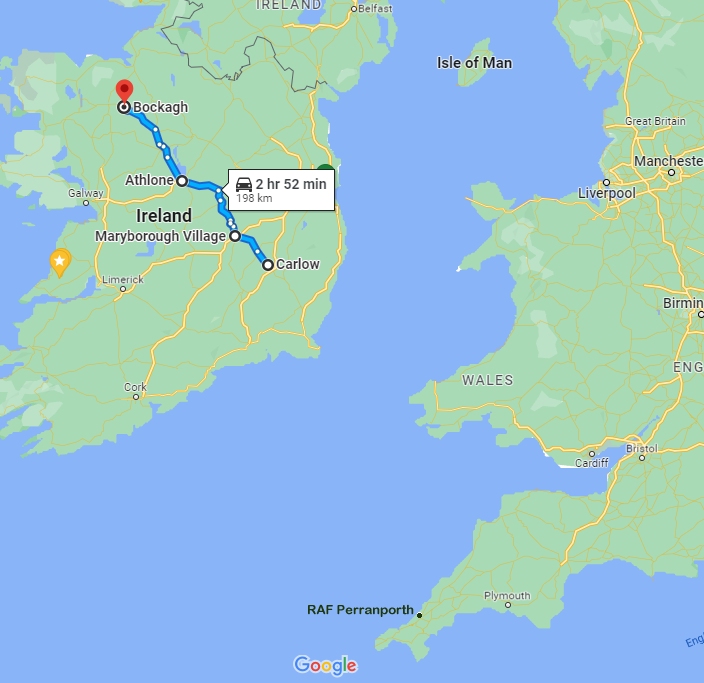
The aircraft was observed later by the Gardai at
Ballaghaderreen in County Roscommon circling two miles north of
the town.
It was reported then in the subsequent Irish Army reports to
have force landed at 13:10 hours on boggy ground at
Boleysillagh, four miles north west of the town. There was
found to be only one occupant on the aircraft, Squadron Leader J
Bowie, 76307 and he was recorded as being uninjured. There
is little other detail in the Irish Army report,
G2/X/1391. The cause of the forced landing is stated as
being "Loss of Bearings due to fog".
Local recollections were found in local history publications
and on social media many years later. Echoes of
Ballaghadeereen published an account of the crash in December
1991, including the story as told by a local man, then deceased,
Mick Fleming. "The late Mick
Fleming of Bohalis recalled how on that day he had been
engaged with some others on road making operations at
Boleysillagh. They saw the plane circling the town,
realised that it was in trouble, and at 1.15 p.m. witnessed
at first hand the nearest approach the inhabitants of
Ballaghadeereen had to the war which had raged for six
years.
The Avro Anson had buried its undercarriage in the soft bog,
but was otherwise intact. Squadron Leader Bowie was
uninjured. Shortly afterwards, a car arrived from the
town bearing the lcoal Garda Sergeant and Dr. Shannon.
The Sergeant asked Mick Fleming who was an L.D.F. member, to
go home for his uniform and mount guard on the
machine. This he did, pending the arrival of the
Armoured Squadron from Boyle."
Sally O'Grady who was ten at the
time, told her memories of the day to her daughter who
posted them to Facebook in January 2017. She recalled
that the aircraft flew very low over their family home, and
that her father was on the roof repairing the thatch.
She was out the back of house having moved some cows when
the aircraft startled her and she ran back to the house
thinking it was a German aircraft. Her recollection
pointed the location of the crashed aircraft to be to the
rear of the family home, understood to be the rectangular
area marked on the image below.
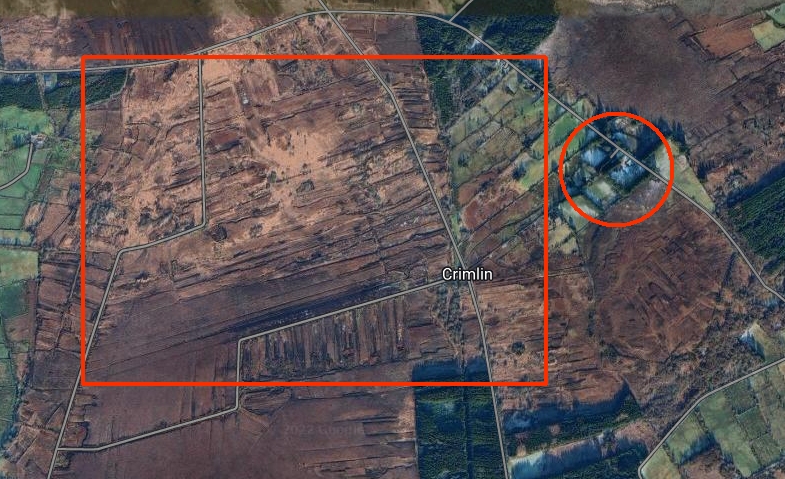
The area is a large one of open bog, as shown in the following photos taken in 2023.
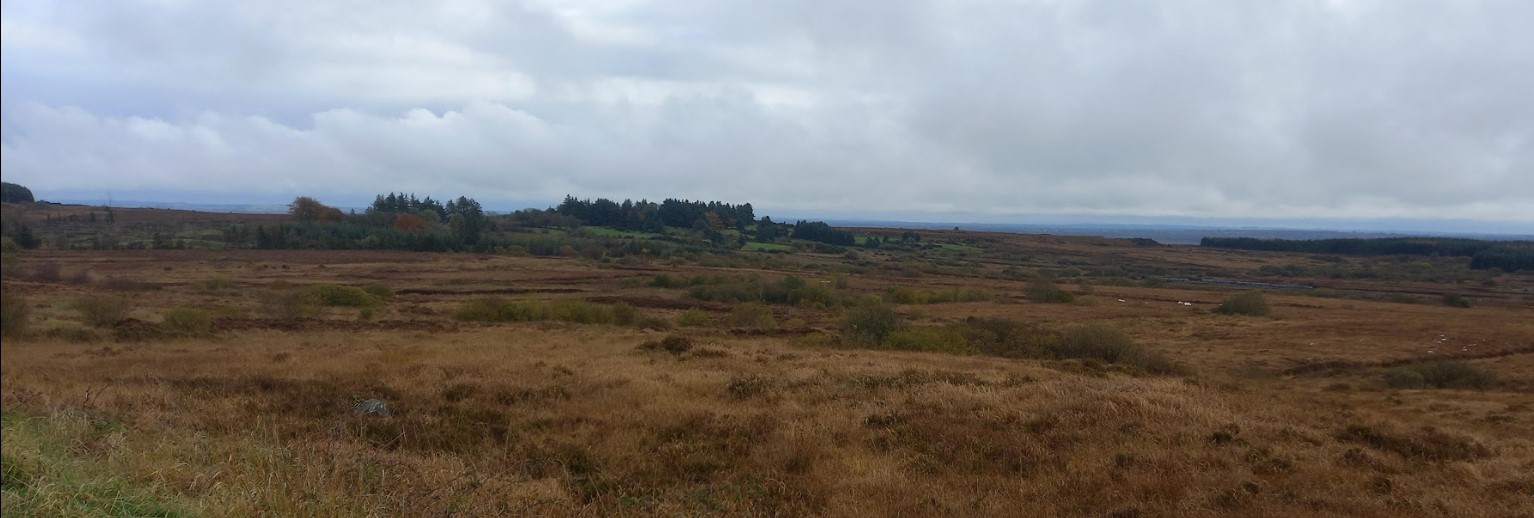

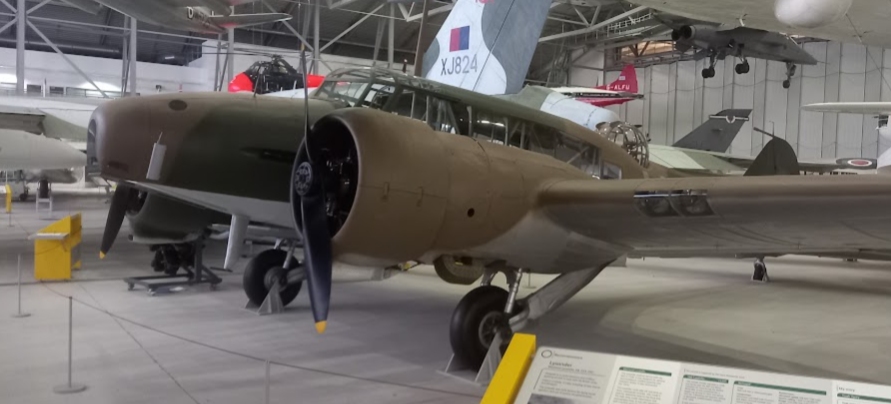
The aircraft, an Avro Anson, similar to the above example
photographed in the RAF Museum in Duxford, was a prewar coastal
patrol aircraft which had long ago been relegated away from
combat missions. The Anson instead served most of the war
as a tireless workhorse in training and transport roles.
The example in this case in Ireland would not have had the
turret fitted.
Sqd/Ldr Bowie was taken to the border via the Grand Hotel in
Sligo by the Irish Army and handed over at Belleek at 21:15 on
the night of the landing. Commandant Power who accompanied
him had later to submit his expenses for refreshments there and
a phone call made by Bowie to Belfast from McDermotts Hotel in
Ballaghaderreen.
The crashed aircraft drew crowds from all over the area that
afternoon and on the following day, the sunday. The 1991
article in the Echoes magazine recalled: IN an article in the "Echoes" some years
back, Michael Murphy recalled how as a pupil of the Brothers
N.S. he had walked for what seemed like miles to the scene,
and how for weeks afterwards, alleged souvenirs from the
plane changed hands at inflated prices in the school."
On the 19th March, Commandant J Power, the commanding officer
of the G2 branch of Western Command, supplied the following memo
on the crash to the staff of G2 Branch in Dublin.
At 13.15 hours on the 10th March, 1945
a British Anson Aircraft No. NK.241. landed ih a Bog
at Boleysillagh, four miles NE of Ballaghadeerreen. The
plane was unarmed.
The sole occupant,No.76307 Squadron Leader Bowie,
Capetown South Africa, was uninjured and was handed over to
the R.A.F. from Castlearchdale at 21.15 hours same night.
Squadron Leader Bowie was proceeding to Belfast on
leave from his station at Parranport, Cornwall, England and
borrowed the plane from a pal to take him. He lost his way
and was observed by Garda at Carlow, Military at Maryborough
and Athlone and Garda at Ballaghaderreen where he was seen
to circle before coming down, on what he thought was good
landing ground, but on touching earth the plane got
stuck in bog and has been salvaged by the Air Corps.
There is an interesting letter written by a Thomas Connell from
Ballymote, Co. Sligo, written to the Military Hospital on the
Curragh. He was expecting that the South African Pilot
would have been 'imprisoned' and would have needed care for the
cut he received on his face. Mr Connell thought that maybe
a relative was married to the pilot. It is interesting
that the military report makes no mention of any injuries to
Sqn/Ldr Bowie.
The Air Britain book, The Anson File, provides a potted history
of the aircraft involved. It had been assigned during
first to 1310 Flight followed by 83 Group Support Unit with its
final assignment being to 19 Staging Post of RAF Transport
Command. The latter unit was an administrative unit based
at RAF station Perranporth in Cornwall, England. The
Imperial War Museum defined a Transport Command Staging Post
as: RAF Transport Command
maintains a series of Staging Posts around the world varying
in size from small airfields to major RAF stations. Their
principle task is the transport of passengers and freight
together with the associated fuelling, repair and
maintenance for the aircraft and the provision of meals and
accommodation for passengers and aircrew.
The staging post system is described in The Royal Air Force
Medical Services, edited by Samuel Cuthbert Rexford-Welch as
being akin to railway services, in so much as the Staging Posts
acted llike train stations for arriving aircraft.
Transport Command was involved with all forms of transport of
personnel, material and aircraft and these administrative units
provided a home for otherwise homeless aircraft and personnel
moving between permanent postings. And it seems, these
could have assigned to them a light transport like the Anson for
general communications and transport flights.
Anson NK241 ended its useful days in the bog at
Boleysillagh. Captain P O'Sullivan of the Irish Air Corps
reported some days after the landing that salvage of the
aircraft was completed on the 17th March. The team stayed
at a boarding house in Ballaghadeereen but were joined on the
second last day by 20 men from Boyle Army barracks and
they assisted in the removal of the two engines. The
condition of the aircraft was described as: Fuselage twisted and badly strained by
landing. Engines and tail plane undamaged." As a result, the engines, instruments and
tail unit were removed and dispatched to Northern Ireland,
being passed over the border at Belleek on St Patricks Day,
17th March. It seems that an RAF Officer, well known
to the Irish military from his many visits to crash sites
over the years, H S Moore, attended the crash site in the
week after the crash in his role as Liason officer with RAF
Northern Ireland. With his agreement it was decided
that the remainder of the aircraft should be burned in situ
to avoid the difficulty of salvage in the bog. It was
commented however in the December 1991 Echoes, that this
might not have happened as some locals recalled using the
wreck as a shelter.
The RAF carried out an investigation into the loss of their
aircraft and the results of this are recorded on the Form 1180.
FB Pilot became lost & had to
force land in a field, bad weather conditions.
Pilot did not make any flight plan or prepare properly
for the flight. Became lost due to faulty
navigation.
Bad visibility on route pilot had to force land.
The Sunday Post of
November 3, 1946 carried the following article referring to
John Bowie.
SCOTS LAD FLIES SOLO FROM AFRICA
Down on to Prestwick's 2200 yards main runway yesterday
afternoon dropped a little yellow biplane.
It was a single-engined Beechcraft Traveller. In it, Mr John
Bowie, a Capetown Scot, was flying solo.
He took off from Prestwick and continued to Turnhouse near
Edinburgh, last night. Mr Bowie left South Africa a
week ago. His route has taken him by Cairo, Tunis,
Marseilles, Paris and London. His actual flying time from
Johannesburg was 20 1/2 hours.
Mr Bowie left his native land for South Africa when be was a
boy of 11. He returned to this country to serve with
the R.A.F. and held the rank of squadron leader.
He piloted one of the Liberators which took Mr Churchillís
party to the Moscow Conference in 1942.
Squadron Leader
John Bowie was born on the 5th February 1900 to Ellen and
George Bowie in Southampton, England.
The 1970 edition of
Who's Who of Southern Africa carried the following entry for
him:
Bowie, John, Property Consultant,
Aucioneer, Prop and Financial Broker, Sworn Appraiser,
Dir. John Bowie & CO (Pty.) Ltd.; joined African
City Properties Trust Ltd.. Jhb., 1914; presently
Hon.Chief Pilot in charge of the SA Red Cross Air
Ambulance: World War I, Pilot, Lt. RFC. World
War II Sqdn. Ldr. Fighter Command RAF; served France,
W. Africa, M.E. and and England (was cmmdr. of one of
the aircraft which flew Sir Winston Churchill to
Moscow); b. 5th Feb. 1900) Scot.; Educ: Scot.,
America, South Africa; sol Rev. George Bowie; m. 30th
September 1937, Edith Waveney, dol Alexander dol
Alexander Rough. 1 s., 1 d.; Clubs: Royal Aero, Cape
Aero. RJGC. Royal Cape Yacht. Cape Aero Club.
Kelvin Grove; Rec: Flying, golf; Add.: 134 Adderley St..
Box 3888, CT Phone 3-1216.
A Medal Rolls Index
Card for a John Bowie, records initial service in the South
African Field Artillery and thereafter as a 2/Lt in the
Royal Air Force during the first world war.
John's service file
reveals his lng wartime career in second line units.
He joined 24 Squadron on flying duties from December 1939 to
November 1940.
His name is found
in the Operations Record Book (ORB) for 24 Squadron, the RAF
transport unit based at RAF Hendon near London, at the end
of October 1940 stating that he had been posted to RAF
Takoradi with effect from 29 Oct 1940. His name
however is not found earlier than this in the 24 Squadron
ORB.
He spent all of 1941 and up to February 1942 at Takoradi, when
he returned to the UK. He spent a few months with the
Ferry Training Unit (FTU) and No 1445 Fligth bringing him up to
January 1943 when he was posted to Nutts Corner in Northern
Ireland. He remained posted there for an entire year
His name has been
found listed is usually in Transport and aircraft Ferry
operations. At times in 1942 and 1943, his name is
again found the 24 Squadron ORB but not on a great many
flights. The mentions of him flying with Churchill to
Moscow for the August 1942 conference with Stalin is yet to
be confirmed. He
is found mentioned just once in Oct 1942 with 511
Squadron, which was the Squadron formed from 1425
Flight, which it seems was the source of the Liberators
that flew Churchill and his party to Moscow. The
crew of Churchill's aircraft, AL504 is well recorded and
Bowie is not among those names.
During 1943 during his posting to Nutts Corner airfield
outside Belfast with 104 Operational Training Unit which
trained crews for aircraft ferrying flights. He was on
board of and possibly the pilot of Wellington Z1460 which
suffered an engine failure on take off and force landed on
the airfield.
1944 seen him spend with No 91 Forward Staging Post, 304 Ferry Training Unit and then return to Nutts Corner and then again on to 45 Group, 173 Staging Post, finished the year at Down Amney airfield.
He arrived in New
York on 17 June 1944 having taken off from Lough Neagh, in
Northern Ireland on American Overseas Airways aircraft 7223,
a Consolidated PB2Y-3 Coronado. He traveled from here
to Montreal and nearly two months later is recorded as pilot
on the delivery to the UK of Liberator RG983. He
returned to New York after that delivery, and back to
Montreal and flew Liberator KH299 to the UK and records no
other ferry operations in that context.
The February 1970 edition of the South African Medical
Journal carried an article about the setting up of the Red
Cross Air Mercy Service, a flying doctors service in South
Africa. John Bowie in that article is described as the
senior pilot.
The only photo
found so far by his family is this post war one, around
1967, of John, on the left, next to a family friend with his
daughter and son in law.
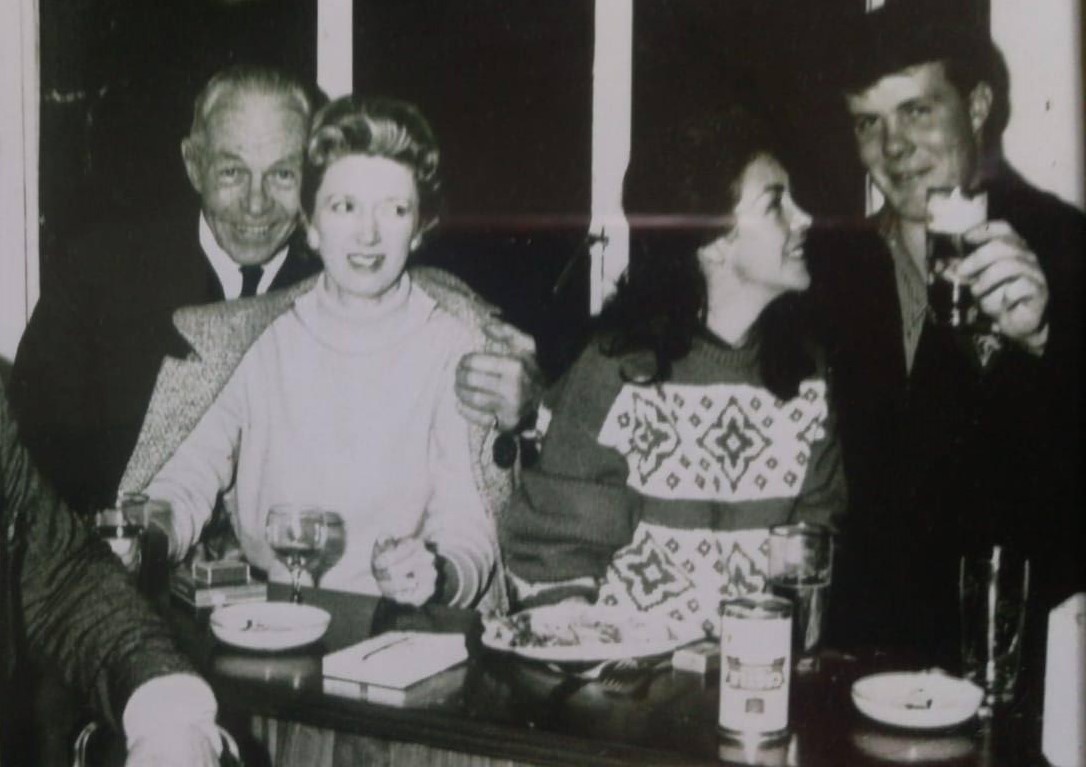
John passed away in South Africa on the 15 May 1974.
Compiled by Dennis Burke, 2022.
